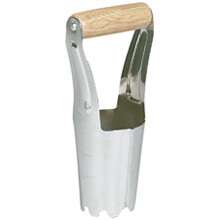Spring bulb displays are popping up all over the place, tempting and teasing with the bright color and promises of bigger, better blooms. Before you start digging, there are a few tips that will help you get a better show next spring.
Make sure the ground has good drainage. If you puddle water in the area where you want to plant the bulbs and it doesn’t seep away within a couple of hours, you will need to add sand or compost to the bedding. My preference is compost or other natural items, since if you have a heavy clay soil like mine adding sand has the tendency to turn it all to cement, where adding compost of peat moss will help break up the ground and cause it to prevent puddling while still allowing it to hold water for the plants roots.
You don’t want to plant flowers in a long line, since it is much more pleasing to the eye if you clump or mass the flowers for bigger impact. Taller alliums are one exception to the rule since their long, thin stems and big, showy flowers make a big impact all by themselves.
If you are planning to mass your flowers together, it can often be easier to dig out  one large section of ground, set them out, then cover them up again, rather than digging individual holes. With my lasagna beds, I had no trouble sticking a hand spade in the ground and popping the bulb in behind the flat of the tool, then letting the ground settle over it. For those with heavier soil, a bulb planter can come in very handy, to remove a bit of ground, place the bulb, then release the dirt back on top again.
one large section of ground, set them out, then cover them up again, rather than digging individual holes. With my lasagna beds, I had no trouble sticking a hand spade in the ground and popping the bulb in behind the flat of the tool, then letting the ground settle over it. For those with heavier soil, a bulb planter can come in very handy, to remove a bit of ground, place the bulb, then release the dirt back on top again.
The general rule is to plant the bulbs with the pointy end up, about 2-2 1/2 times deeper than the bulb is tall, and don’t forget to add some bulb fertilizer to the hole. If you live in really cold areas, you may want to consider going slightly deeper to provide better freeze protection. I have gladiola bulbs, which say they are for zones 8-10, but live in a zone 5/6 area, so a little extra depth and some mulch during the winter help keep these bulbs healthier during the coldest winter freezes.
When you’ve got the bulbs planted, water the ground well to give the roots a jump start.
Also, if you live in an area like mine and have dahlias or other tender bulbs, make a note to dig them up when the foliage dies back and pack them inside in wood shavings or a similar material in a cool place for the winter.


You always have such great advice. Thanks Heather!